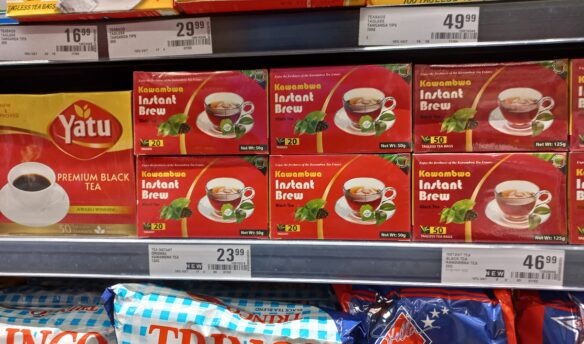[I]n a tea shop steps from the red and golden gates of Chinatown in Victoria, British Columbia, a staff member in a scarlet apron warmly welcomes shoppers with a sample of the tea of the day at Silk Road Tea—today, it’s Japanese sour cherry green tea.
Soft jazz plays in the background, the scent of tea-infused bath and body products fills the air. The merchandising of the entrance is alluring—beautiful teawares, both traditional and modern, from India, China, Morocco, France, and England, are artfully arranged by color, style, and material.
Silk Road Tea, housed in a historic building constructed in 1910, is split into two sections, a result of expansion into a neighboring space. The heart of the store—the tea bar—resides in the second space, with original hardwood floors and exposed red brick walls. Across from the dark wood tea bar is the shop’s “Great Wall of Tea,” showcasing around seventy-five large silver tins of original blends created by shop owner Daniela Cubelic.
The shop is self-serve—customers help themselves to tins in the size of their choice, fill them with tea, and affix a Silk Road label to the top.
Today, Silk Road has two Victoria locations and more than forty employees; this spring, a shop will open in Vancouver’s trendy Kitsilano area. The flagship store is in Canada’s oldest Chinatown. In the late nineteenth century, thousands of Chinese immigrants flocked to the port town during the gold rush and again during the construction of the Canadian Pacific Railway, establishing homes, shops, restaurants, and associations a few blocks from the picturesque Inner Harbour. In the 1920s, immigration from China was restricted, and the neighborhood fell into decline. In the late 1970s and eighties, the city of Victoria began its revival, restoring it to its current, vibrant state and attracting new businesses—like Silk Road Tea, established in 1992.
As a teenager in the 1980s, Cubelic was influenced by the revitalization of Chinatown. Her interest in tea and Asian culture inspired her to apprentice with Chinese and Taiwanese tea masters locally and abroad. She opened Silk Road at age twenty-two. Most of her life has been spent in tea. Holding tea leaves in her hand, she can determine the freshness and the grade, the harvest, the manufacturing method, and if the leaves were stored properly. It’s a skill that Cubelic, hailed by the Globe and Mail as “Canada’s Queen of Tea,” has needed more and more.

“The fact that you were buying loose-leaf tea used to mean that you were buying high-quality tea. That’s not the case anymore,” she says. “You can take low-quality leaves and manufacture them in a way that keeps the leaf intact, so it looks like a better quality leaf than it is.”
Cubelic has used this depth of knowledge to craft more than 100 original blends for Silk Road. Since the shop’s early days, she’s also offered free educational workshops, with themes like cooking with tea, brewing iced teas, and teas for weight loss.
Her expertise extends to teawares and cultural tea traditions, which she sees as a counterpart to enjoying the beverage. She’s studied brewing equipment from around the world and knows the significance of patterns and styles important to tea traditions—the wares she sells come with rich stories of culture and history, stories that are helpful to sales staff when explaining the value of pricey items to shoppers.
For years, customers asked Silk Road to sell its loose teas in tea bags, but Cubelic believed the equipment used to bag tea damaged the leaves. After years of searching, she found a suitable equipment manufacturer in Japan, and in 2014 launched ten blends in tea bags to tremendous success: tea sales increased by 40 percent in the first year, without diminishing sales to loose teas. The resale and wholesale business were a huge part of that growth; restaurants, Cubelic found, were keen to adopt the bags, which are easier to use and help with portion control.

Cubelic’s insistence on high-quality, organic ingredients meant it was only a matter of time until she tried to grow her own tea. Vancouver Island has a moderate climate—it’s one of the few places in Canada that gets little snow—and tea can grow there. In 2009, she planted tea gardens in three top-secret locations in Greater Victoria. In the last three years, the plants have yielded a small quantity of delicately flavored black tea, appearing in the Berry Victoria blend.
Despite the promising harvests, the tea-growing team has yet to determine whether “it’s truly possible to grow good quality, good tasting tea,” Cubelic says. “If we end up with tea with no flavor and no antioxidants, that’s not necessarily a good idea.”
If Cubelic’s tea plants meet her high standard, she will expand the gardens and use their yields in more blends. She also dreams of a day when Vancouver Island will have a whole tea industry, “where you can visit the tea estates, like you do wineries.”
Like the tea bags before, Cubelic says growing tea plants is an interesting challenge. “I think in a long-term way and not in terms of short-term profits. . . . That sometimes means you grow more slowly. But you grow more steadily. You do things in the right way.”
—Jessica Natale Woollard is a freelance writer based in Victoria, British Columbia.
















